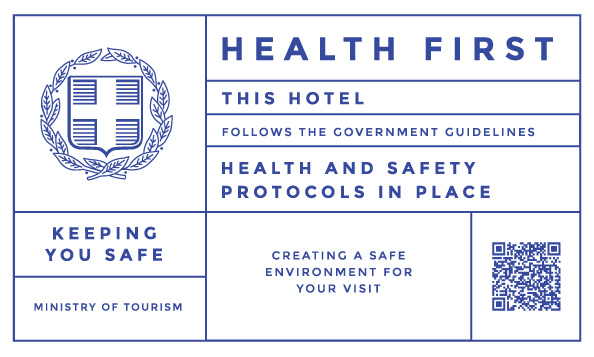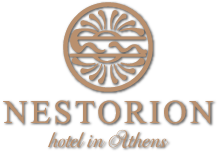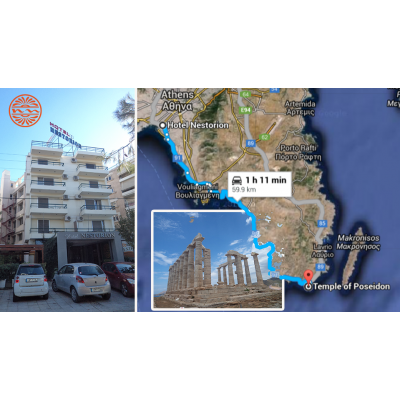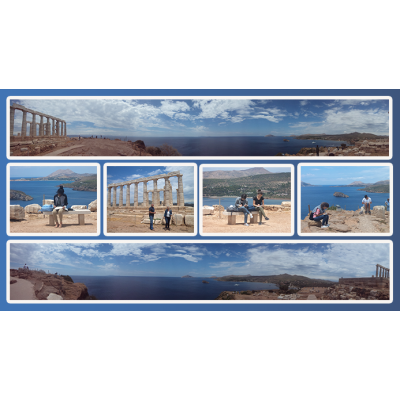From Englad Sounio
the budget hotel in athens
Surely Dave and Janet did not need to travel more with their car. They came from far away England! through France, Italy and Igoumenitsa port - Greece. They arrived at the Nestorion Hotel the evening of 21/06/2015. The joy was great that to see again each other after one year. They accepted with great satisfaction proposal for an excursion extension of their stay in Sounion. The area of Sounion is 59,9 km away from Nestorion and the unknown cape I am sure would impress them!
The coastal route looks like a choreography along the blue of the Saronic sea ..
Together with other visitors we climbed the hill Sounion where the cozy ancient temple was dedicated by the inhabitants to Poseidon the god of the sea thousands of years ago. Many visitors left in their path traces, signatures, dates, designed the temple and painted wonderful scenery. The thousands of years envelop and protect the temple with an eternal thread. Nice clouds crowning him. The Aegean Sea keeps him alive talkative. The Dave and Janet liked it very much and took many photographs in front of him. Young artists illustrating the temple on the paper take with them a nice souvenir.
We are sure Dave and Janet enjoyed the trip and added a happy day in their life with vibrant Greek colors. Crete is the next stop by Dave and Janet! We thank them for their kind words and gentle taste in our hotel! https://goo.gl/maps/NCQyN
The site of Sounion
A steep rocky headland rises 60 m. above the sea at the southern-most tip of Attica. This is the Cape Sounion, the Sounias Akra of the ancient Greeks. The site was chosen first and foremost for its direct relationship, with the sea, since is the last piece of the land seen by ships departing from Athens and the first they espy on returning from their voyage. The strategic position of the promontory for the maritime defense of Attica was recognized later, West of the cape is a bay with sandy beach, a safe haven for ships, while the small closed bay on the cast side afforded protection from southerly and westerly winds.
The Attic landscape was shaped during the Holocene era and has remained more or less the same ever since. The same wooded crag surrounded by the sea is described by Sophocles in his play Ajax, 1218-1220. Cape Sounion is the terminus of the mountainous massif of the Lavreotiki , which Herodotus named "heights of Sunium (Souniakon vounon). The subsoil was rich in alls kinds of metal ores, principal among which was argentiferous lead, which the Athenians exploited intensively. A large part of this region belonged to the ancient deme of Sounion, of the Leontis tribe. The central settlement of the deme was most probably located in the area of Agrileza were also a significant source of wealth.
Most of the citizens of the deme of Sounion were affluent land-owners who were also involved with exploiting the mines. A network of roads linked the cape with the hinterland of the Lavreotiki, the Mesogaia and the asty, that is Athens. Sections of these roads survive at Agrileza and in the coastal zone west and cast of the Sounion Peninsula.
Text written by the Hellenic Ministry of Culture
Visit http://odysseus.culture.gr/h/3/eh351.jsp?obj_id=2390
The coastal route looks like a choreography along the blue of the Saronic sea ..
Together with other visitors we climbed the hill Sounion where the cozy ancient temple was dedicated by the inhabitants to Poseidon the god of the sea thousands of years ago. Many visitors left in their path traces, signatures, dates, designed the temple and painted wonderful scenery. The thousands of years envelop and protect the temple with an eternal thread. Nice clouds crowning him. The Aegean Sea keeps him alive talkative. The Dave and Janet liked it very much and took many photographs in front of him. Young artists illustrating the temple on the paper take with them a nice souvenir.
We are sure Dave and Janet enjoyed the trip and added a happy day in their life with vibrant Greek colors. Crete is the next stop by Dave and Janet! We thank them for their kind words and gentle taste in our hotel! https://goo.gl/maps/NCQyN
The site of Sounion
A steep rocky headland rises 60 m. above the sea at the southern-most tip of Attica. This is the Cape Sounion, the Sounias Akra of the ancient Greeks. The site was chosen first and foremost for its direct relationship, with the sea, since is the last piece of the land seen by ships departing from Athens and the first they espy on returning from their voyage. The strategic position of the promontory for the maritime defense of Attica was recognized later, West of the cape is a bay with sandy beach, a safe haven for ships, while the small closed bay on the cast side afforded protection from southerly and westerly winds.
The Attic landscape was shaped during the Holocene era and has remained more or less the same ever since. The same wooded crag surrounded by the sea is described by Sophocles in his play Ajax, 1218-1220. Cape Sounion is the terminus of the mountainous massif of the Lavreotiki , which Herodotus named "heights of Sunium (Souniakon vounon). The subsoil was rich in alls kinds of metal ores, principal among which was argentiferous lead, which the Athenians exploited intensively. A large part of this region belonged to the ancient deme of Sounion, of the Leontis tribe. The central settlement of the deme was most probably located in the area of Agrileza were also a significant source of wealth.
Most of the citizens of the deme of Sounion were affluent land-owners who were also involved with exploiting the mines. A network of roads linked the cape with the hinterland of the Lavreotiki, the Mesogaia and the asty, that is Athens. Sections of these roads survive at Agrileza and in the coastal zone west and cast of the Sounion Peninsula.
Text written by the Hellenic Ministry of Culture
Visit http://odysseus.culture.gr/h/3/eh351.jsp?obj_id=2390




